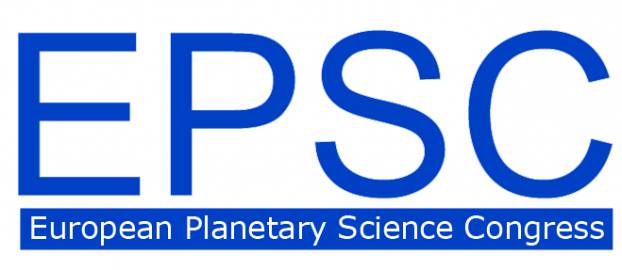EuroVenusians at EPSC2014

September 12th, 2014
This week has seen the annual European Planetary Sciences Congress held near Lisbon in Portugal.
The Venus session - convened by a EuroVenusian - was well attended, with 57 abstracts submitted covering all aspects of Venus science from Venus interior up to exosphere.
EuroVenus consortium members were authors or coauthors of at least twenty presentations:
- Thermal Structure and Radiative Balance of the Venus Atmosphere (keynote talk)
- Thermal structure of Venus' nightside upper atmosphere measured by SPICAV UV on Venus Express
- Thermal Structure of Venus and Mars as Observed by Ground-Based Mid-IR Heterodyne Spectroscopy
- Dynamics of Venus Atmosphere (keynote talk)
- Large scale atmospheric waves in the Venus mesosphere as seen by the VeRa Radio Science instrument on Venus Express
- Venus's Y-feature as a wind-distorted wave
- Composition and Chemistry of the Neutral Atmosphere of Venus (keynote talk)
- HDO and SO2 thermal mapping on Venus above and within the clouds
- The global distribution of \ce{H2SO4} in the atmosphere of Venus as a trace gas for atmospheric dynamics derived from Venus Express Radio Science Experiment VeRa
- Water, halides and carbon monoxide in the Venus upper atmosphere
- Clouds and aerosols on Venus: an overview (keynote talk)
- Aeronomy of the Venus upper atmosphere (keynote talk)
- Long-term Variation in Temperature and Dynamic in Venus Upper Atmosphere from ground-based Infrared Heterodyne Spectroscopy
- Future of Venus Research and Exploration (keynote talk)
- Report on Two Campaigns of Wind and Temperature Measurements of Venus' Atmosphere by Ground-Based Heterodyne Observations at 10μm
- Thermal structure of Venus atmosphere from Venus Express observations
- Towards a Self Consistent Model of the Thermal Structure of the Venus Atmosphere
- Ground-based Doppler velocimetry using CFHT/ESPaDOnS and comparison with simultaneous cloud tracking measurements using VEx/VIRTIS
- Cyclostrophic winds in the Venus mesosphere from VIRTIS-H/VEx temperature sounding
- A New Method for the Detection of Small-scale Wave-like Features in the Venusian Atmosphere with the Venus Express Radio Science Experiment VeRa
The full abstracts for each of these presentations can be found at the EPSC 2014 website: epsc2014.eu
The Venus session - convened by a EuroVenusian - was well attended, with 57 abstracts submitted covering all aspects of Venus science from Venus interior up to exosphere.
EuroVenus consortium members were authors or coauthors of at least twenty presentations:
- Thermal Structure and Radiative Balance of the Venus Atmosphere (keynote talk)
- Thermal structure of Venus' nightside upper atmosphere measured by SPICAV UV on Venus Express
- Thermal Structure of Venus and Mars as Observed by Ground-Based Mid-IR Heterodyne Spectroscopy
- Dynamics of Venus Atmosphere (keynote talk)
- Large scale atmospheric waves in the Venus mesosphere as seen by the VeRa Radio Science instrument on Venus Express
- Venus's Y-feature as a wind-distorted wave
- Composition and Chemistry of the Neutral Atmosphere of Venus (keynote talk)
- HDO and SO2 thermal mapping on Venus above and within the clouds
- The global distribution of \ce{H2SO4} in the atmosphere of Venus as a trace gas for atmospheric dynamics derived from Venus Express Radio Science Experiment VeRa
- Water, halides and carbon monoxide in the Venus upper atmosphere
- Clouds and aerosols on Venus: an overview (keynote talk)
- Aeronomy of the Venus upper atmosphere (keynote talk)
- Long-term Variation in Temperature and Dynamic in Venus Upper Atmosphere from ground-based Infrared Heterodyne Spectroscopy
- Future of Venus Research and Exploration (keynote talk)
- Report on Two Campaigns of Wind and Temperature Measurements of Venus' Atmosphere by Ground-Based Heterodyne Observations at 10μm
- Thermal structure of Venus atmosphere from Venus Express observations
- Towards a Self Consistent Model of the Thermal Structure of the Venus Atmosphere
- Ground-based Doppler velocimetry using CFHT/ESPaDOnS and comparison with simultaneous cloud tracking measurements using VEx/VIRTIS
- Cyclostrophic winds in the Venus mesosphere from VIRTIS-H/VEx temperature sounding
- A New Method for the Detection of Small-scale Wave-like Features in the Venusian Atmosphere with the Venus Express Radio Science Experiment VeRa
The full abstracts for each of these presentations can be found at the EPSC 2014 website: epsc2014.eu

